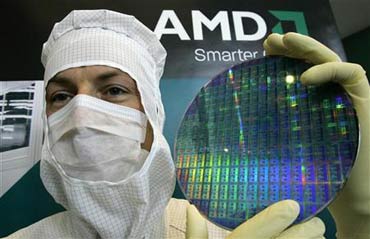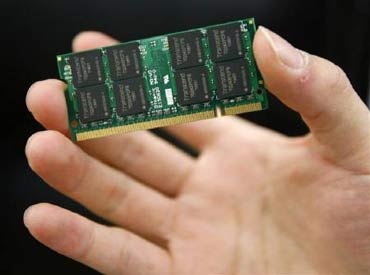 | « Back to article | Print this article |
From an Indian village to designing chips for the world
The story of Dasaradha Gude, better known as 'GD', is almost like a fairytale.
He had his early education in an impoverished village but went on to do engineering in Kakinada. His life as an entrepreneur started the day he graduated from the engineering college.
Later on, unlike many engineers who go for higher studies, he went to the United States to work and make money so that he could start bigger enterprises of his own.
His working life in the field of semiconductors started there as a very basic job of a soldering technician making $4 an hour. Starting from there, he achieved a meteoric rise till he reached rarefied heights on the corporate ladder.
Having resigned from AMD as its global vice president, and also managing director for India recently, he has started his own company, Soctronics. It specialises in providing ASIC design services in both logic and physical design domains.
Currently he is the chairman of Soctronics and VEDA IIT, both based in India.
Here is the story of a serial entrepreneur who has started eight different companies so far!
Click NEXT to read on . . .
From an Indian village to designing chips for the world
You had your childhood in a remote village in Andhra Pradesh. How was it growing up in, like you say, an impoverished village?
Yes, I grew up in a small village called Machavaram in the Guntur district of Andhra Pradesh. My father was a farmer and the village chief.
We used to do dry farming like cotton, chillies, rice, etc. We were not rich but there was no scarcity of food. I used to work in the fields both in the morning and the evening.
There were no middle schools in my village, so after the 7th standard, we used to walk 5-6 km both in the mornings and evenings to the nearby village to study.
I was a good student but my dream was to be a good leader like my father was in the village.
Why did you then decide to go to Kakinada to study engineering?
I wanted to be the village head but my mother wanted me to study. Nobody from my village had ever gone to an engineering college.
There were only a handful of people who had even studied up to the 10th in my village. I was the first from my village to become an engineer.
Click NEXT to read on . . .
From an Indian village to designing chips for the world
You started your own company soon after your graduation. When did the idea to be an entrepreneur come to your mind?
Yes, I started my own company the day I graduated in April 1982. The idea to start a company was there in my mind when I was studying.
I thought, by starting a company of my own, I could give jobs to many people from my village.
We used to design lab equipments when we were students. So, the moment I graduated at 20, I started Amaravati Electronics with four of my classmates and we designed lab equipments.
Then it so happened that a friend of mine who had started a mainframe computer business in Mumbai wanted me to help him.
That was the first time I was introduced to the world of computers. I had had no previous experience with them but somehow it worked. I enjoyed working on mainframe computers!
After that, you decided to move to the United States. Why?
The reasons why I wanted to go to the US were to earn money to start a bigger company and also to learn the technology, bring it to India and start a company with the know how. Many of my friends and relatives also were there in the US then.
Click NEXT to read on . . .
From an Indian village to designing chips for the world
I went to Los Angeles and started at a very basic level, doing soldering for computers! I got $4 an hour. The great thing about the US is that if you are good, you are appreciated. I was promoted every week.
In 6 months' time, I was running a division that had 200 people and earning $20 per hour! I used to run the division from 11 pm till morning. That is the spirit of that country.
I then decided to move to the Silicon Valley because what I was doing was not engineering. I tried to join a firm that designed chips.
They said, you are from an ordinary engineering college and we have only IITians and highly qualified engineers from noted universities in the US. They frankly said I didn't fit in there. However, they needed a helper in the reverse engineering of chip design. But that also, they were not at first ready to give me. My idea was to understand what exactly they were doing.
Anyway, I helped them extract the logic from the chip: that is reverse engineering!
What I did next was, I extracted the next chip for them, not as their employee but as an outsider. I gathered a few unemployed engineers and was able to deliver within a month and we made good money. Soon, the company employed all of us.
Click NEXT to read on . . .
From an Indian village to designing chips for the world
When was your dream of becoming an entrepreneur realised?
I wanted to start something that was technology-driven. Though I worked in the field of semiconductors, as a business it was a very expensive affair at that time.
But I had the know-how of semi conductors. I also understood that semiconductors were going to be the field where I was going to work thereafter.
I was working with Epson at that time. I then quit the job and started my own company -- Top Notch Electronics.
The chief executive of Epson also joined me. Within a short time, we sold it to another company. Then, we started Pacific Semiconductors that designed and manufactured chips in Taiwan.
The arrangement was that we would give the design to them and they manufacture it for us. The difference between ours and Epson's products was that ours were cheaper and customised for new areas.
I started the company based on deals with many companies and people and put together $5,000 to $10,000, and within a year, we were so successful that our revenue was $11 million.
The profit margin was 40%. Soon, our company was bought by Faraday.
Click NEXT to read on . . .
From an Indian village to designing chips for the world
What was the idea behind selling it then?
Six months after selling Pacific Semiconductors, I started Qualcore Logic with a couple of million dollars I got by selling the old one. So, right from day one, the company was profitable. We were into IP designing.
Yes, I came to India (Mumbai) to hire engineers here and trained them to do what I wanted. The idea was to write the design in verilog, a software language.
I moved Qualcore Logic from Mumbai to Hyderabad in 1997 and we were the only one in the field of IP design then. We exported our designs to all over the world, mainly to Japan, Taiwan, the US, and also to Europe.
In 1997, when you exported to other countries, how did they look at a product coming from India?
Things going from India didn't have a good image then. But we had an office in the US and we used that address for all our operations. Only design was done in India because it was cheaper to do it here.
We could manage to sell only because we had an office in the US. Now, the image has changed but in those days, it was different.
Click NEXT to read on . . .
From an Indian village to designing chips for the world
You chose to hire engineers from India at a time when outsourcing was not heard of...
Yes, in those days, outsourcing had not started on a large scale on IP design but I felt it was the best way to run a company.
Our revenues were close to $10 million. Then, I sold it to Zylog Systems for $43 million.
Then I started Cute Solutions which did the software work for IP designing. It was taken over by AT&T Technologies and later on acquired by AMD.
You joined AMD then. What was your role there?
I was the Global Corporate VP and MD for India of AMD, I grew the team from 50 to 1,100. We developed the audio technology for Kodak, multimedia software for all the iPods and we were one of the top five in the world.
We developed both the chip and the software; the complete package. We sold it to cell phone customers like Motorola, LG and Panasonic. We also sell the designs, software and chips for TVs.
For example, Sony Bravia, etc are completely developed here in Hyderabad.
Can you name some of your successes in design?
One of our first successes was a single chip we developed for multimedia mobile phones like LG. We developed it faster and better than the US companies. After that, there were many more.
Click NEXT to read on . . .
From an Indian village to designing chips for the world
We became number one in graphics in the world. Last one was Ontario which is used in net books and tablets. It's a fusion chip developed by AMD design team in India. This chip includes both the CPU (Central Processing Unit) and the GPU (Graphics Processing Unit)
I came out of AMD and started Soctronics which is into semi conductors design and services, a systems and software company that does audio multimedia design for Japanese companies like Sony, Yamaha, AMD, etc.
I want to show Made in India by an Indian company and not Made in India by a US company.
As an entrepreneur, you create companies and then sell them. Why do you do so?
A serial entrepreneur should never get attached to what he creates. You should always be ready to go to the next stage.
And to go to the next level, you need more money which you can get only by selling whatever you create. When you can sell what you create, it shows the success of your product.







